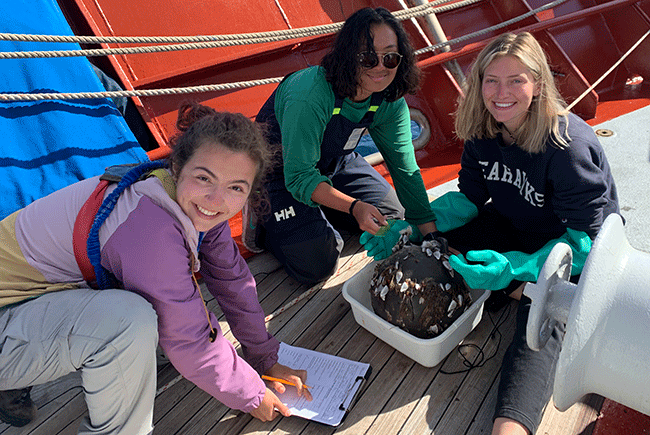Programs Blog
Colonies on Plastic

Authors: Becca Cox, Sophia Garms and Christina Netta, Wellesley College, St. Mary’s College of Maryland and New York University
https://sea.edu/wp-content/uploads/2022/01/P1050884.gif
The amount of human plastic debris in the ocean continues to rise as human production and consumption of plastic persists across the globe. Plastic enters the ocean from the coasts, where improperly managed trash blows to sea, and discharge from rivers, drainage, and sewage systems flow into the ocean. Once in the ocean, plastic follows the movement of currents, leading to much of the debris ending up in the center of ocean gyres.
You might know the North Pacific Subtropical Gyre (NPSG) as the “Great Pacific Garbage Patch,” where the convergence of water masses in the region causes the accumulation of plastic. This accumulation, however, is not quite the trash island that you might imagine. There’s no land mass built upon by heaps of compacted trash like little morphed Lego bricks or like in Wall-E (otherwise, we would have called “Land Ho!” weeks earlier!).
While plastic IS abundant, the majority of marine plastic debris accumulated at the center of the gyre are, in fact, microplastics. These are small, broken down pieces of what once were larger, more recognizable items – they now range from 0.05 to 5cm in size. Though on our voyage we did find an intact laundry basket (with a label so intact we could ring up the manufacturer once we’re on land) and soap bottles, plastic in the ocean is rarely so large. At most, plastic debris in the ocean is only large enough to host relatively small marine critters. As the amount of plastic within the oceans increases, plastic seems to be becoming an abundant resource for these critters – a new habitat called the “plastisphere.”
This summer, aboard the SSV Robert C. Seamans, we researched the presence of organisms colonizing plastic; normally, they like to settle on natural objects like driftwood or kelp. We investigated what kinds of organisms were using plastic for shelter and transportation, their abundance, and whether they exhibited preferences for one type of plastic over another based on factors like texture, color, and degradation. There haven’t been a lot of studies conducted on the ability of plastic to host marine organisms – they’re mostly on entanglement or ingestion.
This made our study very exploratory, and we’ve had to put on our thinking caps to squeeze out our creative juices and be flexible to develop our methods of sample collection and analysis. We gambled on a mixture of luck and skill as we dipnetted pieces of plastic drifting by at the surface within a few feet of the Seamans, and as we discovered larger chunks of plastics that had landed in our Neuston tow. This means that our study focused on plastics that are found within the surface level of the North Pacific Ocean.
As we kept our eyes peeled for potential samples every time we were on deck, we noted the differences between the occurrence of plastic debris in the California Current and the North Pacific Subtropical Gyre. Of our seven sampling stations, only one was in the California Current. It seemed like marine plastic debris was much less common there in comparison to the gyre, where it felt like every time you’re up on deck looking out into the ocean you would see a piece of plastic. And those are just the pieces of plastic large enough to be spotted by the naked eye!
We ended up being able to recover twenty individual pieces of plastic marine debris with colonies growing on them. These included runaway buoys, fishing lines, a detergent bottle, bottle caps, tar, and more. We found that a lot of the plastic samples we found had many colonizing organisms in common, including algae, barnacles, crabs, and others.
Most notably though, was a sample we affectionately nicknamed “Dave” the buoy. Dave was cruising along one morning, being carried by the current, only to be spotted by a few crew members who were aloft on the mast. After an exciting recovery via a smaller boat (and maybe a hundred crabs falling off Dave into the water during retrieval), we saw that the bottom half of Dave was densely covered by algae, over 1400 gooseneck barnacles, isopods on the barnacles, the remaining 80+ crabs, and around 34000 unidentified fish eggs (yes we counted them, what a treat). With Dave’s species richness, population, and the fact that a fish chose to use him as a method of dispersal, he best testifies as to how marine plastic debris can become a new habitat and transport mechanism.
Our study suggests that most types of plastic with which we pollute the ocean, regardless of texture, color, or level of degradation, have the physical potential to host rafting organisms and colonies. While plastic is responsible for entanglement and death of a multitude of marine organisms, it’s also generated new opportunities for certain species to expand their ranges.
Contact: Douglas Karlson, Director of Communications, 508-444-1918 | [email protected]
Recent Posts from the Ships
- SEA Writer 2022, Magazines From the Summer SEA Quest Students
- PIPA Alumni Reconnect with Children of Kanton
- Woods Hole Welcomes Incoming Class of PEP Students
- Muhlenberg Student Finds Perfect Study Abroad Experience with SEA Semester
- SEA Student Describes Pacific Exploration for University of Denver News
Programs
- Gap Year
- Ocean Exploration
- High School
- Science at SEA
- SEA Expedition
- SEAScape
- Pre-College
- Proctor Ocean Classroom
- Protecting the Phoenix Islands
- Sargassum Ecosystem
- SPICE
- Stanford@SEA
- Undergraduate
- Climate and Society
- Climate Change and Coastal Resilience
- Coral Reef Conservation
- Marine Biodiversity and Conservation
- MBL
- Ocean Exploration: Plastics
- Ocean Policy: Marine Protected Areas
- Oceans and Climate
- Pacific Reef Expedition
- S-299 Summer Session
- The Global Ocean: Hawai'i
- The Global Ocean: New Zealand